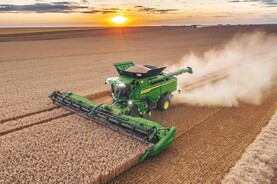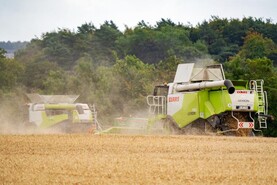Harvest progress
With almost all of the winter barley now harvested it is obvious that average yields are back considerably – some would say by between 0.5 and 0.75 t/ac. Winter oats, oilseed rape, spring barley and winter wheat are now being harvested with variable early results.
Some poor yields were predictable in crops that had burned up some time ago but other crops have done very well. But it’s early days yet. Winter rape harvesting is further on and yields are also lower than last year with 1.6 to 1.8 t/ac being commonly stated yields and an odd crop above 2.0 t/ac.
Stubbles
Given the ongoing difficulties with fodder it makes no sense to leave land idle for up to three months in the case of winter cropping or 8-9 months in the case of spring cropping. Use the opportunity to produce organic matter for your field or to grow fodder for sale. What you grow will depend on your rotation and when you intend to replant.
Catch crops should not be just about GLAS. They have the potential to improve soil health, bring yield benefits and possibly reduce costs over time and to add income. Aim to get catch crop mixes sown as soon as possible to maximise the benefit. Some fields have adequate moisture for germination now – have the seeds sown on the dry ones for when the rain arrives to help speed up establishment. Establish using min-till and use organic manures.
Combine settings and harvesting
This is a very different harvesting year and the settings you use on your combine may need to be altered. As spring barley harvesting begins the challenge of removing awns is and will be evident for a little longer until crops mature.
Where screening tend to be high try and avoid low harvest moistures but then higher grain moistures give somewhat lower specific weights (lower bushels). A slightly tighter sieve and/or more fan speed may help to blow out a few more small grains which might get you under a screenings threshold.
If your sample looks marginal for screenings try and measure it on the go and adjust combine settings to help reduce it. Discovering a problem at the point of delivery could disqualify loads for malting. Reducing small grains may also help to decrease protein content and increase KPH.
Where awns are very difficult to remove it may help to tighten the concave but this must be balanced against broken or skinned grains. One might also increase the load on the concave to try and cause more awns to be broken off during threshing at the risk of losing a fraction more out the back.
Ensure the cutting blade is good and sharp as much of the straw is still immature.
While grain moistures are generally low, maturity is very variable. A sample at 17% may contain grains from 12 to 24%. These could cause problems if stored for any length, especially when the grain itself is cut at high temperatures. Keep an eye on heaps and check for hot spots or deliver for drying almost immediately.






 This is a subscriber-only article
This is a subscriber-only article










SHARING OPTIONS: